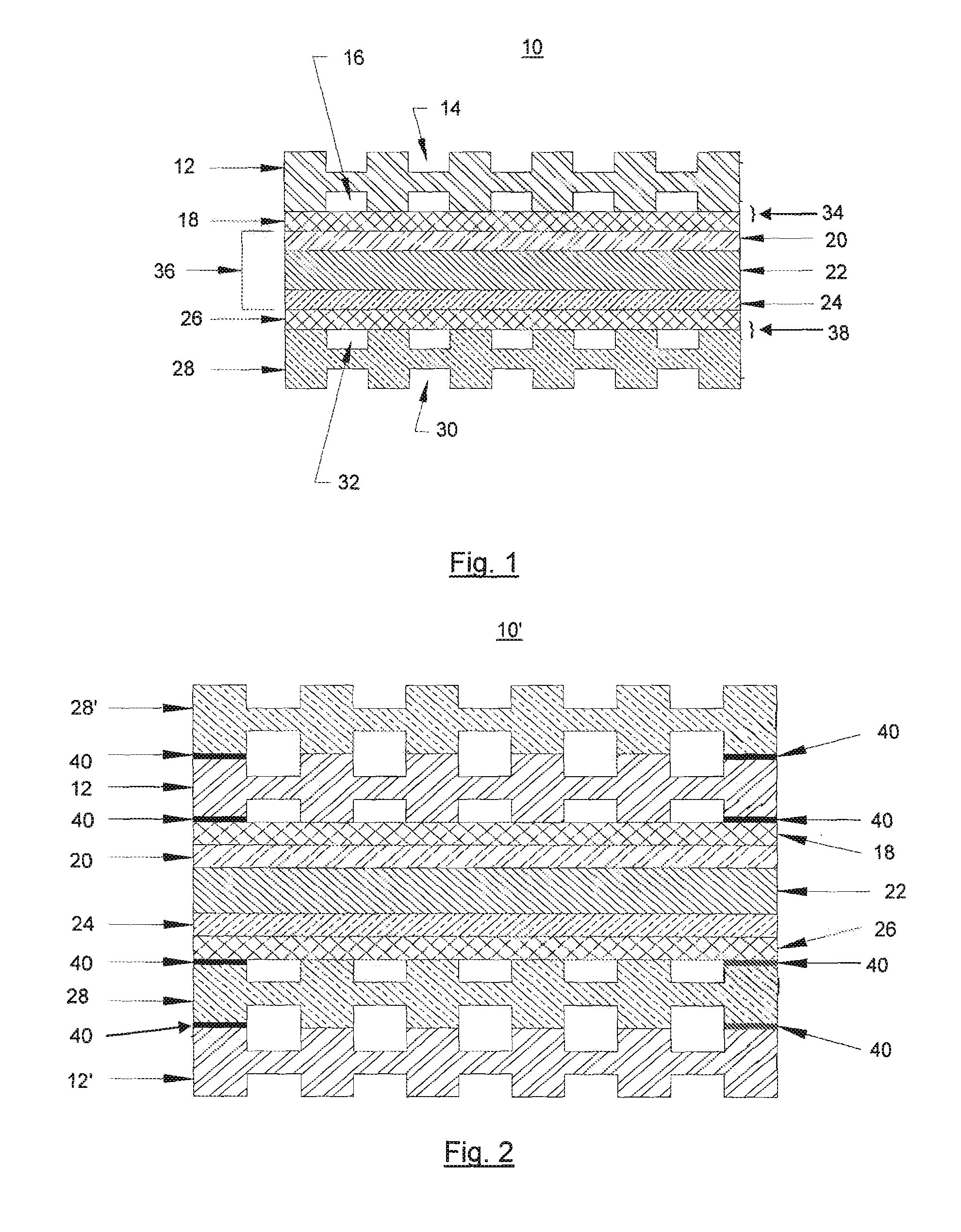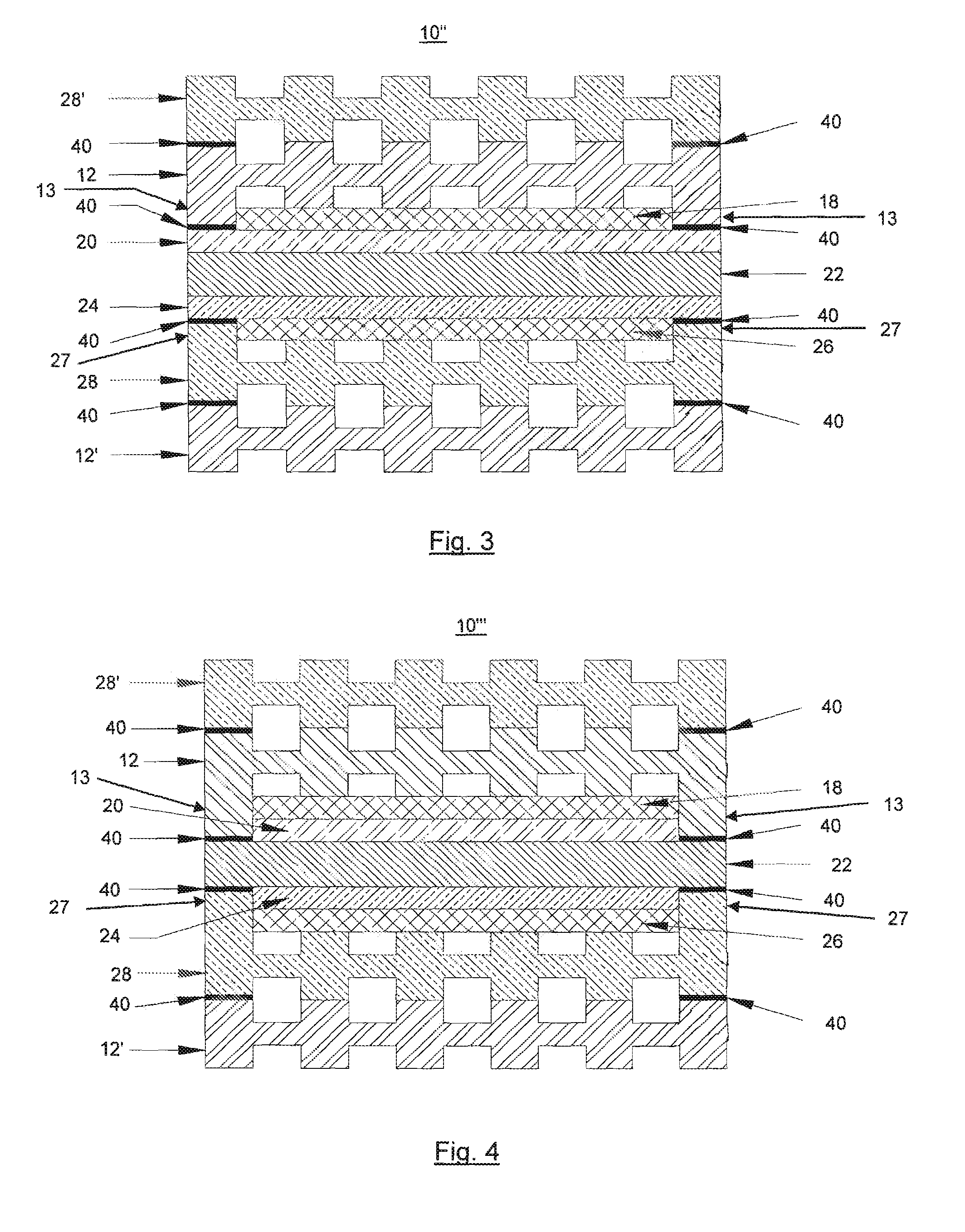Polyisobutylene compositions with improved reactivity and properties for bonding and sealing fuel cell components
a technology of polyisobutylene and composition, applied in the field of polyisobutylene composition for bonding and sealing fuel cell components, can solve the problems of limited cross-linked density and resultant properties of these compositions, and limit the properties of the resultant composition, so as to achieve the effect of improving the sealing against leakag
- Summary
- Abstract
- Description
- Claims
- Application Information
AI Technical Summary
Benefits of technology
Problems solved by technology
Method used
Image
Examples
example 1
Viscosity Data
[0060]Trivinylcyclohexane was very affective in reducing the viscosity of alkenyl functional polyisobutylene resins. Viscosity reduction was observed in a 5,000; 10,000 and 20,000 number average molecular weight (Mn) alkenyl functional polyisobutylene. Details are shown in FIG. 11, FIG. 12, Table 1 and Table 2 for a 10,000 and 20,000 molecular weight alkenyl functional polyisobutylene for inventive compositions 2 through 4 and 6 through 8 and for comparative compositions 1 and 5.
TABLE 1Effect Of Trivinylcyclohexane On ViscosityIn A 10,000 Mn Alkenyl Functional PolyisobutyleneCompar.Inv.Inv.Inv.DescriptionComp. 1Comp. 2Comp. 3Comp. 4Alkenyl Terminated50505050Polyisobutylene (10,000Mn), weight partsTrivinylcyclohexane,02.5510weight partsViscosity (Haake, 1501,500,000650,500234,00067,500RheoStress), centipoiseShear Rate [1 / s]12121212Temperature, ° C.25252525
TABLE 2Effect Of Trivinylcyclohexane On ViscosityIn A 20,000 Mn Alkenyl Functional PolyisobutyleneCompar.Inv.Inv.Inv...
example 2
Differential Scanning Calorimeter (DSC) and Stability Results
[0062]Formulations were prepared with and without trivinylcyclohexane while keeping the molar ratio of Si—H to alkenyl groups and platinum to alkenyl groups constant. Comparative composition 9 shown below in Table 3 was prepared without any trivinylcyclohexane and cured. The composition had a heat of reaction of 29 joules per gram. Inventive compositions 10 through 14, which have different amounts of platinum catalyst, contained five weight percent of trivinylcyclohexane based on 100 grams of alkenyl polyisobutylene. The heat of reaction increased to about 83 joules per gram for the inventive compositions containing trivinylcyclohexane.
TABLE 3Trivinylcyclohexane Addition To Difunctional ResinsInv.InvInv.Inv.Inv.Compar.Comp.Comp.Comp.Comp.Comp.DescriptionComp. 91011121314Alkenyl Terminated100100100100100100Polyisobutylene(5,000 Mn), weightpartsPolyalkyl Hydrogen10.033.233.233.233.233.2Siloxane (2,230 Mn) (1),weight partsTri...
example 3
Formulated Physical Property Data
(Compression Set, Hardness & Mechanical Properties)
[0068]Inventive compositions 25 through 30 were prepared using a constant ratio of trivinylcyclohexane to alkenyl terminated polyisobutylene (PIB) while varying the amount of Si—H to the total number of alkenyl groups by varying the polyalkyl hydrogen siloxane content to measure the change in physical, mechanical and thermodynamic properties. The ratio of the number of “A” functional groups (NA) to the number of “B” functional groups (NB) is referred to as the stoichiometric imbalance (r=NA / NB). It was observed as shown in Table 6, Table 7 and FIG. 13 that as the stoichiometric imbalance increased, the ratio of Si—H to alkenyl groups increased, compression set values decreased while mechanical properties increased. Optimal properties were obtained at a stoichiometric imbalance of approximately 1.4 to 1.0 (Si—H to alkenyl groups). The absolute value of the compression set decreased dramatically to 8 p...
PUM
| Property | Measurement | Unit |
|---|---|---|
| weight percent | aaaaa | aaaaa |
| weight percent | aaaaa | aaaaa |
| composition | aaaaa | aaaaa |
Abstract
Description
Claims
Application Information
 Login to View More
Login to View More - R&D
- Intellectual Property
- Life Sciences
- Materials
- Tech Scout
- Unparalleled Data Quality
- Higher Quality Content
- 60% Fewer Hallucinations
Browse by: Latest US Patents, China's latest patents, Technical Efficacy Thesaurus, Application Domain, Technology Topic, Popular Technical Reports.
© 2025 PatSnap. All rights reserved.Legal|Privacy policy|Modern Slavery Act Transparency Statement|Sitemap|About US| Contact US: help@patsnap.com



